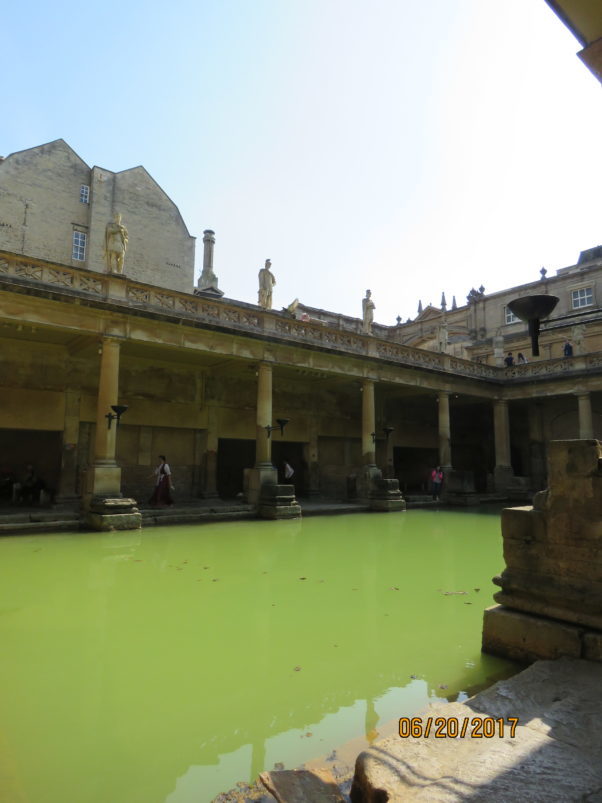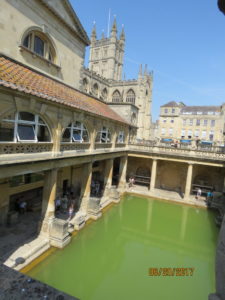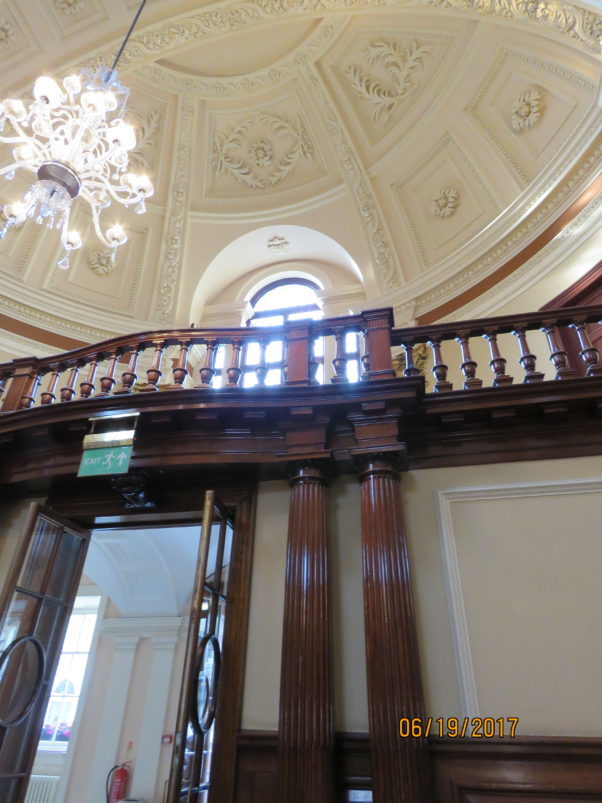by Donna Hatch

When Rome occupied England, the quaint English town now known as Bath was a hub for social, religious, heath, and recreational activities. The sick–those who could afford it–flocked to the healing mineral waters of a warm natural springs. They sought cures, or at least relief, from all manner of health complaints such as palsy, arthritis, gout, skin diseases including leprosy, and many chronic and terminal illnesses. It seems that both genders bathed together, some clothed, some not. I’ll leave it up to your imagination to decide whether they stayed focused on getting relief from their ailments.
The engineering that went into creating the spa two thousand years ago is truly mind boggling. There are many rooms and a complex system of pumps and pipes that carry the water from the main spring to other parts of the elaborate Roman structure.

I might have been tempted to bathe in a shallow tub of the mineral water if I’d been allowed, but I would never have gone into that enormous pool of murky green water that occasionally bubbled — unless I was desperate. It was also kinda creepy not being able to see the bottom.
Still, I had to admire the workmanship that went into the design and construction of the building, and the fact that such an ancient structure remains. It is truly a testament to those who lived and worked here so long ago. In the midst of that venerable structure, I imagined people long gone visiting the spa. In the waters, some frolicked for pleasure, and others simply immersed themselves hoping for a miracle. All of them walked or were carried across the rocks that still bear the wear marks of thousands of feet to immerse in that great pool of water believed to be healing. Men and women all bathed together.
From what I’ve seen, people bathed more or less fully clothed. Bathing suits had yet to be invented so ladies wore gowns the little weights sewn into the hems to keep them down for modesty’s sake. Some sources state that for those who were especially modest, there were some hours limited to a specific gender. For the most part, men and women all frolicked or soaked in the Great Bath together.


Today, the original bath is open for tours but not for bathing so as to preserve its structure. Visitors are admonished not to even touch the water. Modern bath houses provide visitors the opportunity to bathe in the warm mineral waters that many agree have healing properties. Unfortunately, England was in the throes of one of the worst heat waves on record during my visit, so a warm bath lacked its usual appeal.
After the Romans pulled out of England, they abandoned this unique area to the ancient Saxons and Normans. Later, Christian churches arrived.
During the Georgian Era, Bath became a fashionable resort town. People came here to “take the waters,” a Georgian term meaning bathe in the warm mineral pools.
 “Taking the waters” also meant to drink water from the Pump Room, which became a gathering place to socialize and flirt, as well as drink the water they believed had additional healing properties if ingested.
“Taking the waters” also meant to drink water from the Pump Room, which became a gathering place to socialize and flirt, as well as drink the water they believed had additional healing properties if ingested.
Inside the Pump Room is a lovely, antique pump that squirts out water in a continuous fountain to allow those with the desire to sample its offering. The Pump Room I visited was a new version built in 1777 to replace an older one originally constructed in 1706. Apparently, the excavation process of this new Pump Room led to the discovery of the Roman Temple.
In case you are wondering, I did not drink the water when I was there. Remembering its green, murky origins a few feet below, not to mention its smell of Sulphur and its reputation for tasting awful, was enough to discourage my sense of adventure. I suppose if any of my characters ever drink the water, I will have to get more detailed second-hand accounts of its taste.
But let us return to Georgian society in Bath. With the arrival of the wealthy, some of whom only stayed for the summer, and others who made Bath their permanent home, beautiful homes and neighborhoods cropped up, including The Circus, a circular-shaped neighborhood of beautiful townhomes, and Royal Crescent, an even more upscale set of luxury mansion-style townhomes in the shape of a crescent as its name suggests. I toured one of these townhomes, Number One Royal Crescent, which is a glimpse into life as a wealthy, Georgian gentleman.

Jane Austen lived in Bath for several years with her family. While many claim that Jane disliked living in Bath, a large portion of two of her novels, Northanger Abbey and Persuasion, took place in Bath which she portrays as an exciting and lovely place.

Beyond enchanting, Bath has a timelessness about it. Walking the streets, I easily imagined myself a character in a Jane Austen novel. Strolling along the river, having afternoon tea in the Pump Room, prowling the streets, and exploring the Roman Baths creates a sense of having time traveled. With each step I took, I could almost see images of those who’d trod those cobbled paths before me including kings and queens, lords and ladies, and poets and authors including our beloved Jane Austen.
My interest in Bath began long before I visited this fascinating city. Five years ago I wrote my Regency Romance novel, A Perfect Secret, which has a few chapters that take place in Bath. Now I may have to write another book that takes place in this ancient and unique town just to relive my adventures there.

Sources:
My research for this post comes from personal experience as I toured Bath. However, you might enjoy these other sites for more information:

I’m really glad you got to tour Bath and share these pictures with us. Next time I read about Bath , I will remember these photos! Thanks so much for enlightening us!
This was very interesting, I didn’t realize that that the Roman empire included England. The work around the baths is really elegant. Thanks for sharing.
I was briefly in Bath back in 1978 while on a college trip. I was fascinated to be in a place so old. I wish I could afford to go back and spend a lot of time in places we were rushed through then herded back onto the bus to rush off to the next place. I love your photos.
I love georgian historical stories over roman. The baths have hidden caves so could do something about the secret female cult they had. They use to bath in the society fascinated me as well.
I just love the pictues.I have never been but the pictures make me want to go.
Thanks for the great description of Bath. Sounds like a nice place to visit.